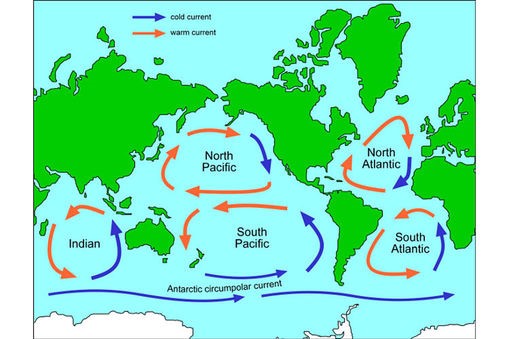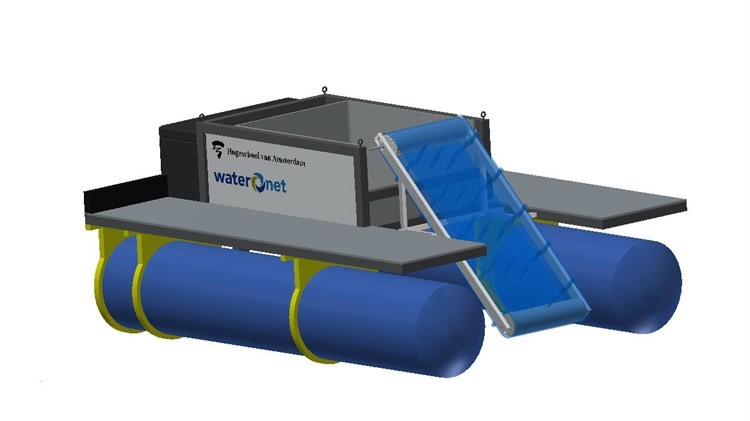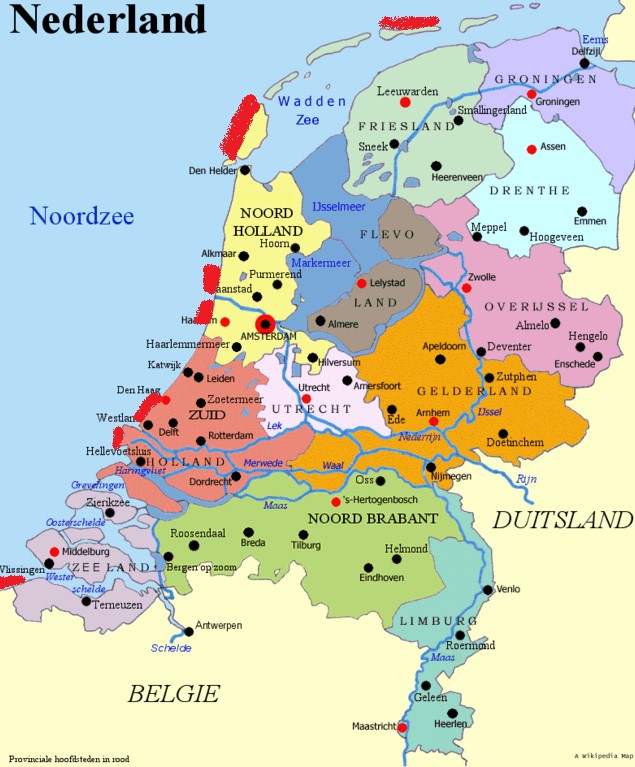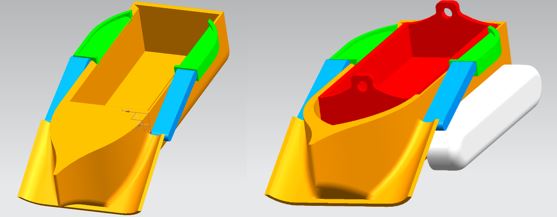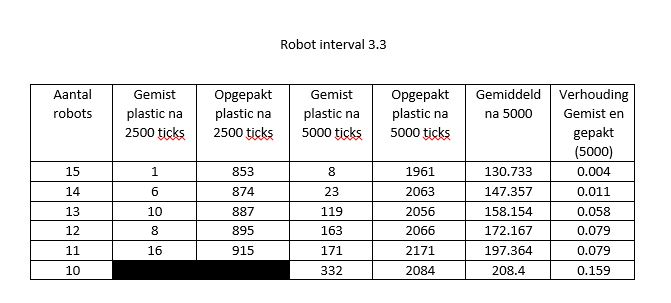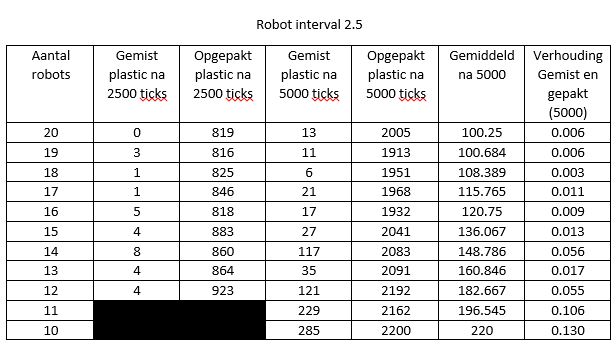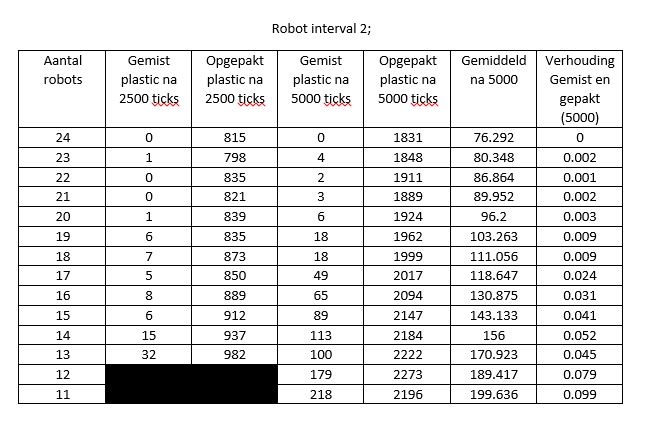PRE2016 3 Groep5
Group Members
| Student ID | Name |
| 0957942 | N.S.A. Messaoudi |
| 0958470 | J.J.J.B. Verstappen |
| 0955491 | C. van Otterlo |
| 0939540 | M.J.M. Smits |
| 0956810 | W.J.P. Goudriaan |
| 0953119 | J.I.A. Spapen |
Introduction
Since 1945 plastic is inseparable from our society, where it brought us great fortune and great use. It is used to carry drinks, package foods, toys, etc. Whereas it has a good side that helps humanity, it also has its downsides. A lot of people throw their garbage, of which most is plastic, very easily on the ground and in rivers. This means the mainland and the oceans get polluted, instead of the plastic being recycled, when it is thrown away. On the mainland there are a lot of organizations, which focus on preserving the mainland’s environment. For example by sending people to collect waste next to roads and beaches. The amount of organizations in the seas and oceans are however, greatly outnumbered. While the organizations on the mainland can hardly keep the pollution at a steady level, the pollution in the seas and oceans has risen exponentially for several years already. The plastic in the ocean decomposes gradually which results in a highly soiled sea which is more difficult to clean up. Even when the plastic decomposes into small parts, it affects and influences the marine ecosystem as a whole. A fish cannot tell food and plastic apart and slowly gets poisoned and killed by the toxic plastic in its stomach. The same happens to many birds that get their food out of the water.
The amount of organizations in the seas and oceans are however, greatly outnumbered. While the organizations on the mainland can hardly keep the pollution at a steady level, the pollution in the seas and oceans has risen exponentially for several years already. The plastics in the ocean decompose gradually which results in a highly soiled sea which is more difficult to clean up. The small parts of plastics influence the marine ecosystem as a whole. Fish cannot tell food and plastic apart and slowly gets poisoned and killed by the toxic plastic in its stomach. The same happens to many birds that gets their food out of the water and even humans can be affected by this. If a fish gets poisoned and a human will eats that fish, then the human will also be affected by the effects.
The plastic that gets in the sea, gathers in so called ‘gyres’. These are huge area’s to which the plastic floats because of the current. It slowly floats in circles in the same area. There are 5 huge gyres around the world. See Figure 1 below.
Figure 1, the 5 gyres in the world
Currently there is a project that is cleaning up these gyres. They put down a giant net in the gyres and let the current of the gyres, pour the plastic in the gyres. This way all the plastic gets pushed into the net and collected in one place. However cleaning up the gyres alone is not enough. The plastic that is in the gyres came from somewhere and the gyres are still growing every day. That’s why it is also important to prevent the gyres from getting bigger, by cleaning up the plastic closer to its source.
The thing that we want to accomplish is preventing the gyre from becoming bigger. We start with that by looking at the coast of The Netherlands. The goal that we’ve set for ourselves is to try to let no plastic/garbage pass through the coast of The Netherlands. The current of the North Sea along The Netherlands is from the bottom to the top or the other way around, which depends on the tides. This is very convenient for setting up places for robots. When a plastic/garbage unit is not cleaned on the beginning of the flow, then it will be cleaned up later by another robot that is on another place at the coast. Also a lot of plastic comes from the beaches and the harbours. It is therefore important to stop the flow of plastic/garbage as close as possible to the source. This is the reason why the agents are placed along the coast of The Netherlands. This will mean that the plastic/garbage will be cleaned up before it comes in the gyres.
Current situation
In order to tackle the problem we set for ourselves we need a good overview of the situation. We did this by writing down all the questions we had about the garbage problem in the North sea and then we started searching for answers. Our strategy was as following; first search for the answer on internet to get a basic intuition and then contact several organizations asking them all the same questions and combine all this information into one final answer.
The main sources we used are either reports or the organizations we contacted. This are the reports we used:
- Wat spoelt er aan op het strand – Stichting De Noordzee
- Mariene Strategie voor het Nederlandse deel van de Noordzee 2012-2020 – Rijksoverheid
- Jaarverslag 2015 – Stichting De Noordzee
- Guideline for Monitoring Marine Litter on the Beaches in the OSPAR Martime Area – OSPAR commission
- The vertical distribution of buoyant plastics at sea: an observational study in the North Atlantic Gyre – J. Reisser, B. Slat, K. Noble, K. du Plessis, M. Epp, M. Proietti, J. de Sonneville, T. Becker and C. Pattiaratchi
The following organizations were contacted:
- CBS
- Rijkswaterstaat
- Kustwacht
- Clean up
- Greenpeace
- Stichting de Noordzee
Of course not all organizations were as helpful as we would have like, but we got enough response to get a complete answer to all our questions. Here are the questions we came up with followed by the answer in italic.
- Is the problem significant enough for organizations like the government to invest money in?
There are several organizations searching for solutions for this problem, which it is significant enough to be solved. Not just the pollution issue in itself is a problem for these organizations, but also the health issues when the garbage breaks down and ends up in the food chain. The government is the biggest investor since it is a societal matter and it is hard for a profit seeking company to make money off. So if we can show the government that our project is the solution for this problem, our project could be worth investing in.
- Which kinds of garbage-objects are most common in the North sea?
There are multiple organizations (Rijkswaterstaat, Stichting Noordzee en NIOZ) that monitor the garbage on the beaches and in the Nortsea. With this data a list was composed, summing up the top 10 most found garbage-objects in and around the sea.
- Ropes and nets
- Plastic pieces
- Plastic bags
- lids
- Candy wrappers
- Balloons
- Plastic bottles
- Wood
- Plastic food packaging
- Industrial plastic contents
- Who are responsible for the garbage in the North sea and where are they located at the coastline?
More than half of the waste comes from the maritime sector. So logically the major port cities are geographical hotspots with regard to the dumping of plastic waste in the North sea. Other pollution comes mainly from the people visiting the beaches, so crowded beaches are also potential hotspots. Also the rivers are highly polluted which makes the places were the rivers goes into the ocean as a dumping hotspot
- Are there hotspots were the garbage gathers (under influence of the current), are these hotspots on the coastline and/or in sea? If they exists, were can they be found?
Generally speaking the plastic gets smaller in terms of size the further one distances itself from the coast. Our focus is mainly on the larger pieces of plastic, so in combination with the previous question, the hotspots can be recorded around the mouths of rivers and harbors and along the coastline crowded beaches.
- What is the order of magnitude of the garbage that is in the North sea, do you have exact numbers?
Regarding soil pollution of the North Sea, we are talking about 110 pieces of plastic per square kilometer in the North sea. Pollution along the coastline is 380 pieces per debris 100 meters beach.
- At what depth is can the garbage be found?
The greatest concentration of debris is around or on the surface. There has been measured up to a depth of 5 meters, and from this it was found that 80% of the waste was in the first 2-3 meters. Which will be further explained in the chapter garbage distribution in the Appendix.
- Are you familiar with comparable project like ours, if so could u give us some information about the projects?
A similar project is the ocean clean up. The idea is to be achieved on a large scale waste in the North Pacific gyre using two long arms. However, this project is on a much larger scale with higher concentration of waste per km ^ 2 so not really applicable to our problem.
Another project undertaken by water network. It has created an autonomous agent, named Nautonomous, which navigates through the water and gathers waste on a treadmill, this agent can be seen in Figure 2.[1]
Figure 2, Nautonomous
Another similar project was set up by the recycled Island Foundation. they make a sort of trial and place it on the coast of Rotterdam in strategic places and capture that way plastic.
Solution
Different concepts
During the project a few different designs and possible solutions were created. These vary on a wide spectrum. Following are some of the concepts created.
The retrieval arm
The first design was to construct a boat with a number of arms on it to pick up each piece of garbage separately. While this would be a good option, since it could grab pieces that are two to three meters deep. The programming of an arm is a whole project in and of itself. also this design would make the boat too unstable when picking the garbage out of the water due to the large amount of mass moved. Nets on either side The second design was to make a boat with nets on either side that would rotate whenever a piece of garbage is caught. However this could also catch fish which is unwanted. Also the design is not energy efficient because of the fact that it needs to move the nets in a rotational way which would consume a lot of energy.
Conveyor belts
The third design was to make a boat with conveyor belts to guide the garbage to a center flow area where they would be scooped up by another conveyor into a compartment. This design also was not very energy efficient. A lot of energy would be lost in moving the conveyors and the non-hydrodynamic design. It also could only pick up garbage that floats on the surface of the water.
Ramp to catch garbage
The final design was to make a boat with a ramp in the water. This way the garbage drifting two to three meters deep in the water can be pulled to the surface where they will be transported via conveyor belts on either side of the boat into a compartment for storage. This design will generate a lot of downwards force due to the giant ramp in the water, this can however be prevented by putting a floater or engine in the front to compensate for the downwards force.
Requirements, preferences and constraints
To make sure a good design is made there is a large list of RPCs constructed. These are split up in the following categories to make it easy to read:
Dimensions:
- The boat needs to be two by three by three meters. This is so that the boat can still hold a lot of garbage. It also makes sure the boat is stable and it provides a large frontal area to pick up garbage.
- The compartment needs to be 1.5 by two by two meters, this way it can carry a lot of garbage without having to be emptied.
- The compartment needs to be separable in order to decrease downtime when emptying.
- The clips holding the compartment in place need to be easily removable for easy separation when emptying.
- The vehicle needs to have two floaters on each side (0.25 by 2 by 2.5 meters) in order to keep the boat floating in the water. Via Archimedes’ law this means that the floaters will stay in the water for 80 percent with a full compartment.
- The boat needs one ball-shaped floater (radius 0.6 meters) to compensate for downwards drag when moving through the water.
- Space needs to be available for the conveyor belts on either side of the boat. These are needed to pull up the garbage once it is out of the water and transfer them to the compartment. This space would equate to 0.25 by 1 by 0.5 meters.
- There must be a guiding slide to transfer the garbage pulled up by the conveyors. The space would equate to 0.25 by 1 by 0.2 meters.
Material:
- The boat and the compartment are both made of polyester. This material is used in the construction of sailboats and is both strong and light.
- The floaters need to be made of polyether since it is the most used material for floaters in general.
- The whole vehicle and all of its parts need to be waterproof to prevent it from sinking.
Transferring:
- The vehicle needs to have a motor to move forward.
- It needs to have a fin located in the water to steer.
- It needs to have a large enough battery in order to fill its compartment and return to a charging station.
Sensors:
- The vehicle needs to have a laser sensor in order to check if its compartment is full and needs to emptied.
- It needs a GPS system to locate its position and to make it back to the nearest pickup point when a storm is inbound.
- The agent needs an internal measurement unit in order to make sure it is still on the right path when picking up garbage.
- It needs to have an internet connection to check the weather for conditions in which the agent should not be on the water and to communicate with the control station if there is a part that has broken down or the agent needs to be called back to a pickup point in event of an emergency situation.
Life-cycle:
- The agent needs to keep working for 25 years, to minimize costs and to make sure it can keep cleaning the ocean, which unfortunately is never done.
strategy
For the robots, to gather plastics, as efficiently as possible a gathering strategy has to be made. To overstretch the whole area, a strategy in which the robots move vertically would be a logical approach. In that way it seems that almost all of the plastic on top of the surface of the water will be gathered. However, due to the fact that most of the plastics in the North sea are found at a depth of 1-3 meters, this strategy will not be sufficient enough. Therefore a new strategy has to be considered.
To gather the plastic that are 1-3 meters deep in the water, 2 slides are designed in front of the robot. These slides are 1-3 meters deep and pushes the plastics to the surface of the water. To stimulate this upwards thrust, the strategy will be adapted to the figure below:
Figure 3, Strategy
In this strategy the robot will navigate in the opposite direction of the current of the water. In this way the plastics will collide to the slides and will be pushed due to the cooperation of the current and the speed of the robot. The best way to stimulate the thrust is to navigate the robots horizontally, parallel to the coast. However when the total area has to be covered there will be a lot of robots needed to gather all the plastics, therefore the strategy in the figure is the final strategy. In this strategy the following are presumed. The area which the robots will clean has a width of Y meters and a height of X meter. When tides shift, the current reverse direction. The tides shift every six hours [2]. Furthermore the average speed of the current is equal to 1.15 meters per second. According to the RPC’s the robots need to navigate with a speed of at least 3 meters per seconds, this means that in 6 hours a robot can travel a total amount of 64800 meters. To estimate the size of the area it will be presumed that the robot finishes n spikes at the total width of Y meters. De X and Y can be calculated by the following formula
64800=2n*√(x^2+(y/2n)^2 )
When the Y varies between 100 and 300 meters we can calculate the height X with the following formula:
x= √((64800/2n)^2-(y/2n)^2 )
In the table below the different Y and X are shown, together with an approximation of the total amount of robots.
table 1, size of the area.
We wanted the X to be around 50 meters and therefore the size of the last row is chosen, with an approximate value of n.
Furthermore, we assume that at least 10 robots should be behind each other to gather plastics when the robots in front of them miss them. Furthermore these extra robots are necessary to cover the area when the other robot is emptying its container.
In the model part, the optimal amount of robots and the optimal angle in which the robots gather the plastic in the area is chosen by simulating different robot numbers and different angles.
The question remaining now is where the robots have to be placed to clean up the North sea, while not being disturbed by boats, birds, sailors and so on. It is very difficult to take the birds that rest on the robots into account, therefore the focus lies on human disturb factors. According to the information provided in the environment chapter, the following locations are proposed:
Figure 4, Locations
These locations are based on tourist locations, harbors and places where rivers go into the sea. These locations are according to state of the art research the hotspots where plastics goes into the North sea. As can be seen in the figure above, the direction shift of the currents are also taken into account by placing robots on both sides of the river.
Model
Model design in CAD
During the project two models were made, the first one functioned as a basis to make decisions upon, such as what sensors to use, pickup strategy and efficiency among others. The second model created is the final design, this design solved the practical problems and limitations that came up during the rest of the project.
the first design
The first thing that came to mind when designing the agent was the fact that it needs to pick up garbage efficiently. A lot of options came up in the initial designing phase. Arms to pick up the garbage, giant nets to trap garbage in etcetera. However these options were not efficient enough, it needed a lot of programming to move the different parts and a lot of energy would be lost in picking up something. So the decision was made to design an agent that could pick up garbage by moving through the water. The main inspiration for this was the nautonomous project and some concept designs made
--- links to sources to be implemented ---
And so the first design was made, it uses conveyor belts on the outside to move the garbage horizontally towards the center in front of the agent and then uses a second conveyor to move it from the water in a compartment. The agent would be kept afloat using two floaters on either side and can move forward and steer using two motors at the end of each floater.
However, the first design had a few problems. First of the conveyor belts were fragile and would get a lot of pressure put on them when moving through the water against the flow. The outside conveyors were also held in place by relatively thin beams which would break easily. The second problem with the original design was the fact that the front area was big and was not hydrodynamic which would lead to a lot of water friction when moving. And lastly, most of the garbage which would be floating in the seas is up to two through three meters deep in the water. With all the limitations mentioned before, the agent would not be able to pick up all of the garbage. Since the friction forces would get too large when trying to get garbage out of the water.
Figure 5, First design
The second design
With all the limitations in mind, the second design was made. The new design picks up the garbage in the front and guides it to the surface without a large friction force. From there the blue conveyors will pick it up and guide it upwards. The conveyer belts will drop it off on the green panels which guide it further to the storage compartment. This way the design has fewer dangers in breaking, compared to the first design. It no longer has belts kept in place by thin beams, but a big front plate integrated into the front. The only conveyor belts left are located above water and therefore do not face such large forces as the first design. Secondly, the new design generates less friction due to the front plate and can pick up garbage which is located as deep as two to three meters. All together this will greatly reduce maintenance and power usage. And lastly it has a compartment that is easily to be taken out and emptied.
Figure 6, Second design
Considerations for Cad model
Detecting Waste in the ocean
In this section we will define three types of robots. The first are robots that clean the ocean via brute force, this means they keep cleaning the same designated area over and over until they have run out of battery to the point their program tells them to move to a charging station. The second type are robots that use sensors to recognize the shape of plastic and other pollutions and move to the location to clean it up. After they’ve cleaned up the garbage they start scanning again. And lastly the third type are robots that use ultrasound to scan the ocean for garbage and use the same cleaning procedure as robot prototype two. Below follows a description of the different types, good and bad aspects and both construction and operating cost.
Brute force option
Description
This prototype will have all the basic necessities, this means storage, motors, the ability to float on water, GPS and a mechanism for retrieving garbage from the ocean. It’s way of working is via brute force: from the central communication center it will get allocated to an area of the ocean. Once the robot arrives at its location it will start moving over the whole area, sweeping up every piece of garbage on its way. Once it is done it will start over again until the battery level hits a certain threshold or the compartment is full, after which it will make its way over to the charging station and get its compartment emptied as well.
Good and bad points
Good:
- Simple design
- When the path of cleaning is well designed, it should have few pieces of garbage seeping through its area
- Compartments can be smaller due to the fact that more robots need to be used for cleaning
Bad:
- Needs a lot more agents than the other two options due to the fact that it’s using brute force instead of targeted cleaning, or the cleaning can take much longer than when using the other options
- Even with good cleaning paths the garbage can get through
- More agents means more charging options and more substitution agents to fill up the gaps from travelling agents, which can in turn cost more
Cost
The costs of this option will be the least of all the options listed. Due to the fact that this option uses only the features that are absolutely necessary in this robot. But the fact that more robots could be necessary (see above), the costs could go up.
Shape recognition option
Description
This prototype will have all the basic necessities as described in the previous prototype, but it will also be outfitted with a camera and shape recognition software. From the central communication center it will get allocated to an area of the ocean. Once arrived it will start scanning the area for shapes it deems worthy of cleaning up. When it sees a shape it perceives as plastic, it will move over to the location and clean it up, storing it in the compartment. When done it will move on with scanning and the cycle will start over again until the battery level hits a certain threshold or the compartment is full, after which it will make its way over to the charging station and get its compartment emptied as well.
Good and bad points
Good:
- Targeted cleaning means less agents than brute force cleaning
- Less agents means less charging options and substitute agents which means lower construction and operation cost
Bad:
- Technology is not yet advanced to the point that it is a feasible option due to the recognition range
- Pixel distortion and image distortion can lead to recognition of non-existent garbage
- In scanning and cleaning garbage can seep through if the software is not correctly calibrated.
- Cameras have no depth perception when using a single camera, since it only tracks pixel data and no distance
- Some things that are garbage might not be received as such
cost
The costs of this option would rise severely owing to the fact that shape recognizing technology is fairly new to the market, and new technologies tend to cost more than technologies already longer existing. The implementing of this technology could also cause a rise in the costs. The size of the sensor would cause an increase in the dimensions and weight of the robot, amongst other things.
Ultrasound option
Description
This prototype will have all the basic necessities as described in the first prototype, but it will also be outfitted with an ultrasound device. From the central communication center it will get allocated to an area of the ocean. When it gets there it will start scanning the ocean for pieces of plastic and other garbage. When it sees something it perceives as garbage the same procedure as the second prototype is initiated.
Good and bad points
Good:
- Targeted cleaning means less agents than brute force cleaning
- Less agents means less charging options and substitute agents which means lower construction and operation cost
- Wide scanning area
- Tracks depth
- Can recognize garbage that is underwater
Bad:
- Small objects might not be recognized, as they are seen as noise or get lost in continuous error and noise adjustments.
- Maritime life can be seen as garbage and therefore cleaned up.
- Presumably very sensitive to adjustments
- Might have low accuracy compared to prototype two
Cost
The costs of this option will lie in between the costs of the other two options. The ultrasound technology has been on the market for a longer time, so it is further developed, and also cheaper and less than shape recognizing sensors. Another advantage is that waterproof ultrasound sensors already exist and could easily be bought. Ultrasound sensors sell at prices between $10 and $250. We need to determine the scanning range in order to choose one type of ultrasound sensor, and with that its price.
Our choice
We chose for the brute force option, because the robots work in teams on different spots in the North Sea, which lowers the importance of picking up every piece of waste that passes the spot in which the robot works. If one piece passes one robot, another robot can pick it up. For this robot, there is no need to add the extra features mentioned above, and this will only increase the costs of the robot.
Picking up waste from the ocean
There are different options from which can be chosen regarding picking up waste from the ocean. We considered a simple fishing net, a sort of arm with a basket attached to it, and a slide which would force the waste to the surface of the ocean, where it could be picked up by a conveyor belt. Below, the different (dis-)advantages and costs of every option are discussed.
Fishing net
Description
This option would be about the same as the fishing nets used by the fishing industry (see Figure below), but smaller and used only two meters below the surface of the water.
Figure 6, First design
Good and bad points
Good
- Can cover large patches of ocean
- Many different net sizes to choose from
- Many options for the size of the holes in the nets
- Waste of all sizes can be picked up
Bad
- Hard to determine the right size of the holes in the net, too large and waste may not be trapped, too small and other things than waste may be trapped in the net
- Fish that swim close to the surface of the water could also be trapped by the net
- How to empty the net into the on-board storage container without humans on board?
- Takes up a lot of space
Cost
Recreational fishing nets aren’t that expensive, but when looking at more professional fishing nets, the costs can rise pretty quick, they can cost between 100 and 200 euros.
Arm with basket
Description
A visual representation of this option can be seen in the image to the right. A basket, with small holes (so the water doesn’t end up in the storage container) can move up and down around an axis, picking up waste objects.
Good and bad points
Good
- Can pick up every piece of waste passing
- The size of the basket can vary, so bigger waste objects can also be picked up
Bad
- The friction force of the water causes the need of a strong motor or servo for turning the axis
- What material is the basket made from?
- If the basket is in the process of picking up a piece of waste, and another piece passes, it can’t pick up the other piece of waste, this is inefficient
- All the electronics need to be at the back of the robot, which can cause the robot to be very heavy in the back and therefore unstable
Cost
Since this option will be needing a strong motor or servo, the costs can rise pretty quickly. Also, the material of the basket could be something that has to be designed from scratch, which can cost a lot of time and money. A simple fishing net could be used, of course, this could also solve the problem of the friction force of the water. But using a simple fishing net gives the problems mentioned in the section of the simple fishing net.
Slide with conveyor belt
Description
This option will use the upward force of water. On the front of the robot, a slide is made. When a waste object is in the path of the robot, it will bump against the slide, the slide will force the water and the waste object upwards (toward the surface of the ocean). When at the surface, a conveyor belt, made of plastic, with plastic spikes, will take over from the slide, and bring the plastic object further upwards until it falls into the storage container. The conveyor belt will have holes in it, so that the water, which has been forced upward, falls back into the ocean.
Good and bad points
Good
- Every piece of waste in the path of the robot is picked up when using this method
- Using forces outside the robot to pick up waste (water’s upward force)
- All the robot has to do is sail it’s path and keep the conveyor belt running
- No fish and other things than waste will be picked up using this method
Bad
- All waste objects that aren’t in the robot’s path aren’t picked up
- It may cost a lot of energy to keep the conveyor belt running all the time
Cost
The slide and the conveyor belt can both be made out of plastic, which just has to be shaped in a specific form. Since we use the form of a slide, we used the costs of a children’s slide as a base for the costs of the slide. These cost around 30 euros. For a plastic conveyor belt of 60 cm wide, a price of about 150 euros per meter has been found.[3]
Our choice
We chose the slide option. One of the major advantages for us was the fact that no harm is done to marine wildlife when using this method. We want to clean up the ocean, not damage it’s ecosystem. Furthermore, the disadvantage concerning not picking up every piece of waste can be countered by the same argument used for the brute force navigational option: other robots can pick it up. We also like the simplicity of the solution, the robot doesn’t need any extra sensors of knowing when to rotate (like with the basket). We feel the extra costs for the slide and the conveyor belt are well spent, if marine wildlife can be spared.
Netlogo model
In this part of the project, a model was made that simulates a certain amount of robots cleaning up an area of the North sea with a width of 300 meters and a length of 54 meters. The purpose of the model was to determine the optimal number of amount of robots by simulation. As said earlier in the chapter about the strategy, the velocity of the agents has to be at least 3 meters per seconds. In the model this has become 4 meters per seconds because the chance of missing pieces of plastic is smaller. This is determined by simulating the model a few times.
The agents have to empty their container, when their containers are full. In the total width of 300 meters there are 6 stations, where the robots can empty their containers and refill their energy level. The initial energy is chosen very high, so the chance of getting the container full is greater then the chance of running out of energy. These stations are located at 25, 75, 125, 175, 225 and 275 meters. We estimated the charge time at around 8 ticks because we hope that emptying the container will be executed as efficiently as possible.
The rest of the model can be seen by clicking on the link below:
https://drive.google.com/file/d/0B-QPPQg1oPoeOTNNUlpybFNkemc/view?usp=sharing
The result of the simulation with the respect to the amount of robots are given in the tables located in the chapter data of model in the Appendix. When the date retrieved is taken into account the following can be concluded. According to the model 13 agent are needed with a robot distance of 2.5 meters. This means that 1,64 percent of plastics are missed.
Appendix
Garbage distribution
Before we can start with designing our robot we need to have an impression of where our target, the garbage, is located. After contacting several organizations we were able to make a proper estimation of how the garbage is disturbed in the North sea.
Starting off with the depth of the garbage, research has shown that in a water column of 5 meter, starting at the surface, 80% of the it can be found in the top 2 to 3 meters [4] . However, these numbers follow from measurements done in the North Atlantic Gyre, so do they also hold for the situation in the North sea? Without going to much in physical detail, we will try to explain if the North Atlantic ocean is comparable with the North sea. A object floats if it has a smaller density then the liquid. Density is a ratio of mass and volume and since these quantities are the same in both situations we can assume the results of the study are also applicable for the North sea.
The second variable is the distance of the plastic to the coast. Since we couldn’t find any reports with the necessary data we contacted Rijkswaterstaat. It turned out there isn’t any specific data, but the rule-of-thumb is; the further away from the coast, the smaller and less dense the garbage gets. Combining this information with location of the hotspots (outlet of rivers, harbors and beaches), only a few potential locations remain.
data of model
Table 2, Dataset 1
Table 3, Dataset 2
Table 4, Dataset 3
References
- ↑ https://www.youtube.com/watch?v=BYXlv8fgj80&feature=youtu.be
- ↑ http://www.ebvloedgetijde.nl/
- ↑ http://www.safeconveyor.com/Modular-Plastic-Conveyor-Belting-Pricing.php
- ↑ The vertical distribution of buoyant plastics at sea: an observational study in the North Atlantic Gyre – J. Reisser, B. Slat, K. Noble, K. du Plessis, M. Epp, M. Proietti, J. de Sonneville, T. Becker and C. Pattiaratchi
links
drinkwaterzuivering:https://www.evides.nl/drinkwater/hoe-wordt-mijn-drinkwater-gemaakt
waterzuivering (idee): http://www.nationalgeographic.nl/artikel/oceanen-weer-schoon-dankzij-boyan-19
http://www.plasticsoupfoundation.org/feiten/gevolgen-voor-het-milieu/
http://www.plasticsoupfoundation.org/feiten/gezondheidseffecten/
http://www.icgrevelingen.nl/blog/2016/01/14/cleanriverproject/
http://www.boatdesign.net/forums/sailboats/speed-average-sailboat-18365.html
https://www.theoceancleanup.com/
http://www.tedxdelft.nl/2012/10/tedxdelft-first-performer-boyan-slat/
https://plasticsoepsite.wordpress.com/onstaan-plasticsoep/
https://www.theoceancleanup.com/technology/ Ocean clean up
http://www.wur.nl/nl/Dossiers/dossier/Plastic-afval-in-zee.htm wetenschappelijke artikelen
